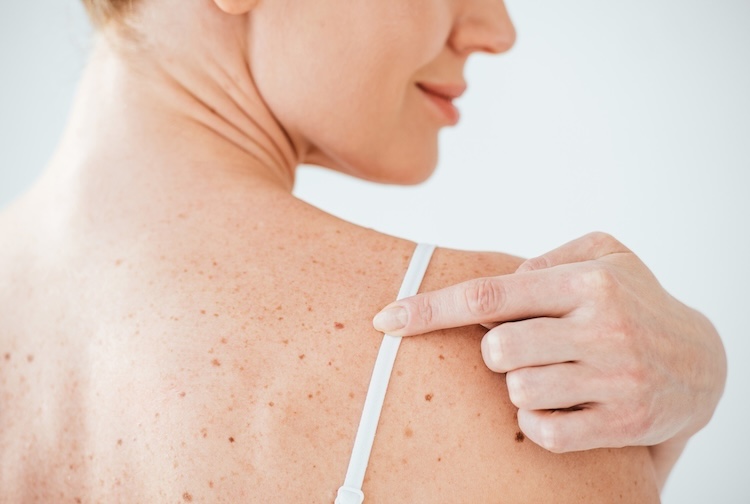How to check yourself for sun damage and signs of skin cancer
A step-by-step guide to screen for skin cancer at home and prevention tips from a leading dermatologist at VCU Massey Comprehensive Cancer Center.
July 21, 2025 VCU Health experts recommend taking photos of any lesions or changes in your skin. Then, come back to it in a few weeks or a month to see if the spot looks any different. (iStock)
VCU Health experts recommend taking photos of any lesions or changes in your skin. Then, come back to it in a few weeks or a month to see if the spot looks any different. (iStock)
By Tatiana Del Valle
While many people only think of skin cancer during the summer, the sun poses a risk and causes skin damage year-round.
Skin cancer is the most common type of cancer, with one in five Americans diagnosed in their lifetime. Fortunately, many patients can live long, fulfilling lives with this disease since there are many treatments and medications available.
Routine screening is essential to catch skin cancer in its early stages – and one way to do it is at home.
Kimberly Salkey, M.D., a dermatologist at VCU Massey Comprehensive Cancer Center and VCU Health, spoke with us about the importance of skin cancer screenings and how you can perform self-exams at home.
.jpg) Kimberly Salkey, M.D., is a dermatologist at VCU Massey Comprehensive Cancer Center. (Enterprise Marketing and Communications)
Kimberly Salkey, M.D., is a dermatologist at VCU Massey Comprehensive Cancer Center. (Enterprise Marketing and Communications)
What are the common signs of skin cancer?
When examining your skin, be on the lookout for three things:
- Outlier lesions, anything different than any of your other spots.
- Changes in your old spots, such as a mole or spot that’s been the same forever that now has changed in size, shape or color.
- Sores that don’t heal. Normal skin ought to heal after a reasonable amount of time, but if something just keeps a scab on it and never completely heals, that deserves attention from the dermatologist.
Can you walk us through how to perform a self-exam?
You should do a self-examination about once a month. You don’t have to memorize every single spot, but you do want to have the gist, so that if something changes in a big way, it gets your attention.
The best time to do it is after getting out of the shower or before you get dressed. Here’s a process to go through:
- Look at yourself in a full-length mirror.
- Examine your face, chest and the entire front of your body for any changes.
- Then, take a seat and look at your feet, including between your toes and the bottoms of your feet.
- Use a hand mirror to look at the skin on your back.
- Some areas are more difficult to see, like behind the ears or on the scalp. When you get your haircut, remind your hairstylist to let you know if they see anything in those areas.
Are there any other hiding spots where skin cancer is often missed?
Places that people may not think about are the palms of their hands, soles of their feet and nails. I have patients who keep their nails painted all the time. When you go to the salon and the polish is off, take a look at your nails for any changes. Sometimes people don’t think to look all the way under the arm and even in the genital area, so look at your groin too.
What is the difference between melanoma and other types of skin cancer?
The most common kind of skin cancer is basal cell carcinoma, then squamous cell carcinoma and, fortunately, a distant third is melanoma.
We think about basal cell as a shiny bump sometimes described as translucent, which can almost look like a blister. Squamous cell is usually more scaly, kind of dry and usually red at the base.
The thing that makes melanoma different is that it has much more potential to spread throughout the body. Basal and squamous cell have some potential to do that, but they are very slow-growing and much less likely to spread.
A helpful tool to spot melanoma is the “ABCDE” rule. If you notice one of these characteristics in a mole, you should have it checked by a dermatologist because it may be an early sign of skin cancer:
- A is for Asymmetry. One half doesn't match the other.
- B is for Border. Uneven, scalloped or notched edges.
- C is for Color. Multiple colors, changes in color or uneven color.
- D is for Diameter. If it is the size of a pencil eraser (1/4 inch in diameter) or larger.
- E is for Evolving. Changes in size, shape, color or height, or new symptoms like bleeding, itching or a sore that won't heal.
How can I keep track of changes to my skin?
We use photographs a lot in our clinic at VCU Massey Comprehensive Cancer Center. I encourage patients to do that at home too. Take a picture of a lesion or change on your skin. Then check it again in a few weeks or a month to see if it looks different.
Does skin cancer appear differently in different skin tones?
Yes, skin cancer does look different for different skin tones. And because it is sometimes less suspected or less noticeable in darker skin tones, these patients are often diagnosed with skin cancer at more advanced stages.
Sometimes things like redness that you might see as part of a typical skin cancer are harder to pick up on darker skin tones. But it’s important to know that everyone is at risk for skin cancer.
How else can I protect my skin from the sun?
It’s important to be aware of how much skin is exposed, when the sun’s UV rays are the strongest and that you’re using strong enough sunscreen.
Use sunscreen with at least 30 SPF. If you want to get the best benefit from it, reapply every two hours. And if you’re using spray sunscreen, be sure to rub it in.
Avoid direct sun exposure between peak hours, from 10 a.m. to 4 p.m. That doesn’t mean you can’t go outside during that time but be in the shade as much as you can.
Another option is sun protective clothing. On top of sunscreen, garments with a UPF rating of 30 or higher, hats and sunglasses will offer good protection.




